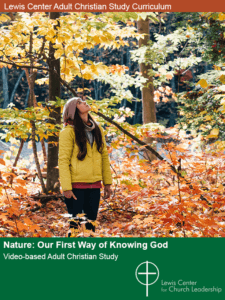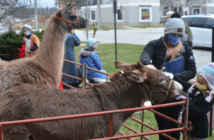
Why do we feel comforted, healed, and enlivened in nature? Beth Norcross explains it is because God is so present there. In this episode we discuss how nature is our first way of knowing God and how individuals and churches can connect with this deep wellspring of spiritual meaning.
Listen on Apple Podcasts | YouTube Music | Spotify
- Transcript
-
Announcer: Leading Ideas Talks is brought to you by the Lewis Center for Church Leadership of Wesley Theological Seminary in Washington, DC. Subscribe free to our weekly newsletter, Leading Ideas, at churchleadership.com/leadingideas.
Why do we feel comforted, healed, and enlivened in nature? Beth Norcross explains it is because God is so present there. In this episode we discuss how nature is our first way of knowing God and how individuals and churches can connect with this deep wellspring of spiritual meaning.
Ann Michel. I’m Ann Michel, associate director of the Lewis Center for Church Leadership of Wesley Theological Seminary and host for this episode of Leading Ideas Talks. My guest today is Dr. Beth Norcross. Beth is founder and director of the Center for Spirituality in Nature. She’s an adjunct faculty member at Wesley Theological Seminary who has developed and taught courses in eco-spirituality and eco-theology. And I’m pleased to share that Beth has collaborated with the Lewis Center on a soon-to-be-released video study curriculum for use in local churches. It’s called Nature: Our First Way of Knowing God. So I’m delighted to be talking today with Beth and hearing from her about how we can know God through nature. So welcome, Beth.
Beth Norcross: It’s great to be here and it was such a privilege to do this resource with you.
Ann Michel: So I thought maybe you could share just a bit about your own spiritual journey and how it is that you’ve come to have such a passion for spirituality in nature.
Beth Norcross: I appreciate that, Ann. And I think that I’ve always been a nature lover from the time that I was small. But it’s only in the last several years that I’ve started to connect my faith in with the natural world. I think, as many of your viewers have experienced, there’s just something about nature that opens us up and makes us sense and feel the presence of God in a way that’s just not available in any other way. And as I said, I always have been outside, but it wasn’t until recently that I started to really recognize that the reason that I felt so comforted and healed and enlivened outside was because God was so present there.
Ann Michel: So I think there’s a tendency among some Christians — and I think I’m guilty of this myself — of thinking about spirituality in nature as maybe pre-Christian or somehow post-Christian. And one of the things that I admire so much in your work, one of the things I’ve learned from you, is how to apply the lens of our biblical faith and our Christian beliefs to interpreting God’s presence in the natural world. So my question is this: If nature is our first way of knowing God, as you say, I’ve been wondering, why do you think it is that it has received relatively little attention within the historic stream of church tradition and within churches today, as well?
Beth Norcross: Well, it’s a good and important question. And it goes all the way back to Platonism, this separation, I think early in the church, of body and spirit. And some confusion and contentiousness between the church and science over the years. But I would suggest that our Christian tradition is actually very rich with a nature-based spirituality, despite the fact that the church itself might not embrace it wholly. We can look at the Desert Fathers, and I’d like to think there were some desert mothers out there as well, who took to nature when the church got a little bit too institutional. They went to the natural world to find God. The mystics, of course, always a very rich, traditional way of finding God in and through the natural world. The Celts, as we discuss in the class, these two books, The Book of Nature and The Book of Scripture. So I think those strands are there. And now, of course, they’re being picked up and rediscovered as the church itself morphs and people fall away for a variety of reasons. Young people in particular are looking for something more enticing, more unmediated. And nature is that place. It feels to me like we’re returning to our roots in the Christian tradition, as much as anything in our biblical tradition. Also, as we talk about a lot in that in the class, in the work and the workshops is really full of these allusions to the natural world. And they are just ripe for rediscovery.
Ann Michel. So it sounds like you’re saying that the strands of this are always a part of the Christian tradition and maybe they just haven’t been as emphasized as they could be or maybe should have been, but that there does seem to be a resurgence of interest in this now today. Why do you think there is a resurgence of interest in it today?
Beth Norcross: Well, I think it’s informed by a number of factors. As I said before, I think people are falling away from church for a variety of different reasons and yet still looking for something, I think that’s all of the surveys suggests that, yes, people are walking away. Many, again, especially the young from the established church. But that doesn’t mean they are still not yearning for something deep within them. So I think that’s one thing. But also, you know, the climate crisis, the environmental crisis, people are looking at that with new eyes, I think in particular over the last several years, and saying, “Whoa! Wait! Wait a minute. What’s going on out there?” And not only should we be paying attention through our behaviors and lifestyles, but what is God saying to us in this moment and turning back to God and saying, “Wow! This is the creation. This is the gift, the most precious gift that God’s given us. What are we doing with it?” And in so doing, we’re by turning our attention back to the natural world, back to the creation, we can’t help but find the Creator there as well.
And certainly, I should say, over the last year, we’ve seen article after article. In fact, there was just an article over the weekend in The Wall Street Journal that says that people are coming back to nature in droves during this time. And why? Because they’re looking for something. They’re looking to be comforted. They’re looking to be healed. They’re looking to have some kind of a meaning out of these strange and provocative times that we’ve all been going through. And so it’s a natural thing to be reaching out to sources of wisdom. And it’s no surprise to any of us that they’re finding that in the natural world. And so I think it’s a deep need. It’s deep yearning that’s pulling us back to our original way of finding God. This is in both our biological DNA, the Earth is, and also our spiritual DNA. It’s a return to The Garden, if you will, that I think that we’re all seeking.
Ann Michel: You mentioned how many younger people are maybe not finding natural points of connection with the traditional church these days. And so a lot of people talk about those people as “the Nones,” the people who claim no particular religious affiliation. Or sometimes people talk about those people who are “spiritual but not religious.” And we know that that’s a growing percentage of the American populace, particularly among the younger generations, among Millennials and people who are even younger. And as you’ve indicated, there’s research that suggests that people who fall into these categories tend to find spiritual meaning in their daily life. So friends, family, art, community, beauty. And one of those places that’s identified as being an important source of spiritual meaning for people who aren’t connected with the church is nature. As someone who is deeply committed to the church, I look at this and think, “How can churches connect with this impulse that people feel, to find spiritual meaning in nature and connect with it as a way of reaching out to this segment of the population that’s not drawn to the institutional church?” I wonder if you have thoughts about that.
Beth Norcross: Well, I do have a number of thoughts along those lines. I think the church and certainly the Methodist Church is one that is looking at all different forms of gathering. And we have been over the years, part of the system of “Churches of the Wild,” our sister organization “The Wild Earth Spiritual Community” is such an organization. It is drawing a really wonderful group of both young and old. And I know that the established churches are looking to different ways of finding meaning, and these Churches of the Wild are one way to do that. But in the context of the church itself, we have several programs through our Center for Spirituality and Nature that seek to do that. One is through spirituality and nature groups. Churches are looking for ways to have smaller, more spiritual gatherings. And so those can be found in the natural world, in the context of your existing church establishment, especially now when many churches are still not meeting inside, they can go out safely in small groups outside. So that’s a very important thought.
Secondly, we’re working with a number of local churches now to rediscover their own sacred grounds. And I worked with a church in downtown D.C. that had what only could be described as a postage stamp yard right in the middle of bustling Washington, D.C., not far from the White House. And we did some spiritual walks out there and found just the most extraordinary riches and God, of course, so present. So if we can, as a church, extend our notion of sanctuary, extend our notion of sacred ground, to include the non-human part of the natural world. Of course, seminaries have a great deal to say about that as well. It was a privilege to start with some colleagues the Green Seminary Initiative, so pastors themselves can begin to see nature and to see, say, sanctuary and to see sacred ground differently.
Ann Michel: How about with children and youth? I mean, I would imagine this is a natural way of connecting with children, just with their curiosity and their sense of awe about things. I think some of the most powerful experiences I’ve had of God in nature were as a young person. Do you do you work with children and youth at all? Or have ideas for programming that would engage children and youth?
Beth Norcross: We do. We’ve actually just started some family programs. And I’m so glad you brought this up. You asked about my background. As many of us, I went to church camp and loved that experience. And children being with children in the natural world can be so rich for them and also for us, for us as well, because there’s a natural delight and wonder and curiosity and there are wonderful, wonderful resources. Joseph Cornell has put out so many interesting nature-based resources. Richard Louv talks about “nature deficit disorder” and how important it is to get children outside. What I don’t see as much of his spiritual resources for children outside to start making the intersections for children, the connections between what they’re seeing and what they’re hearing and where God is present. So many different children’s Bible stories could be enriched by making those connections. They’re just one step away.
You know, we talk in the in the class about Noah and the Ark. And that’s a favorite children’s story. But we could delve into that just a little more deeply and make that connection of how important each of these animals was to God, which is why God included them in the ark, and how important they are to our survival, where we’re really in the same boat. And so those are some things that Sunday school curriculum are just beginning to address.
People ask me a lot, I’ve recently gotten like a lot of questions about how to bring teenagers outside. And I would just say to that, I’ve changed my thinking on that a little bit. First of all, having raised a few of them myself, let them bring their friends with them. And I’ve begun also to just encourage them to, or not discourage them from, bringing their phones and turning into the skid and allowing them to take pictures and Snapchat and just enjoy the natural world and God in it to some degree, on their own terms and in ways that they find meaning.
So but bringing children, you know, we’ve had many, many studies that suggest that children need to be in nature so that they can understand the world of science and math and so forth. It cannot be understood in a vacuum, really. And so I would say that, too, if there’s some spiritual truths that can’t be taught to children without being outside where we first met God.
 Coming soon from the Lewis Center — Nature: Our First Way of Knowing God. This seven-session video-based adult Christian study awakens our visceral knowing of the Creator through the creation, reconnects us with the sacred landscapes we call home, encourages us to provide space and time for spiritual reflection in nature, and helps us live in greater harmony with God’s earth. Learn more and preorder at churchleadership.com/nature.
Coming soon from the Lewis Center — Nature: Our First Way of Knowing God. This seven-session video-based adult Christian study awakens our visceral knowing of the Creator through the creation, reconnects us with the sacred landscapes we call home, encourages us to provide space and time for spiritual reflection in nature, and helps us live in greater harmony with God’s earth. Learn more and preorder at churchleadership.com/nature.
Ann Michel: One of the wonderful contributions of this study that you’re offering is that you provide the example of lots of different spiritual practices that people can integrate into their daily life in order to be more deliberate in encountering nature and encountering God in nature. For the benefit of our listeners, could describe one to give an example of the kind of thing that you’re talking about?
Beth Norcross: Well, thank you. We’ve actually put out a book, if I could just put a brief plug in for our book Inside Out, which has 50 spiritual practices that can be done and are actually designed to be done in nature. And I should say at the outset, many were adapted from children’s nature-based educational models. So one that I really love and come back to a lot, especially since we’re so constrained now — so many of us have our own backyards, the apartment complex, urban, suburban lawns, and so forth — is to consider that ground that around you is sacred ground, where you might be. And so take an acorn or a rock or something in your in your yard or a local park where you might find yourself. And just give it a toss. And then wherever it lands, draw a circle three feet from the center. So its diameter is six feet. And make a circle. Either an artificial circle or one in the dirt. And just spend some time in this little piece of God’s ground.
You know, I’ve done this dozens of times and people think it’s the silliest thing. And then they get in there. And just for five, 10 minutes, get down on your hands and knees and see who lives there. Who are your neighbors? Where are they getting food? What’s going on in there? What colors are present? What smells or what sights and sounds and so forth are present in this space? And it really can be an extraordinary experience. And then and you might ask yourself, “Is God present here?” My guess is you’ll say, “Well, of course God is present there and coming to us in and through the creation.” It can be a very powerful thing. You can do it for five minutes.
Ann Michel: Yeah, I love that example! And so many others that are in the study that you’ve worked with us on. You stress really doing things that are close to home and part of your daily life. I think a lot of us imagine that in order to encounter God in nature, we have to go to the Grand Canyon or be at the seashore or places of great grandeur that for sure I think do inspire a transcendent feeling. But we don’t have to go someplace else to experience God in nature. Wherever we are, we can find ways of doing it, which is such an important message.
Beth Norcross: I think it is. I think it is, Ann. You know, we talk a lot about pilgrimage. And we did a program that so many of us were constrained. And so we did a series of programs this year called “Inside Out”, where we would do them online, but people would run outside in their backyards and then they would come back and they were really wonderful. And one of them was a pilgrimage to your own backyard. What if we took that same excitement and interest and curiosity to our own backyards that we would if we went to any pilgrimage site — to Iona, or any particular sacred site, or the Grand Canyon, or Yellowstone? What if we took that same interest and excitement and applied it to our own backyard? There are so many riches there. Since I’ve been doing these in my own backyard, in fact, I’ve tried to stop calling it “my backyard” because there’s a propriety and a paternalism that comes from that. So anyway, “the backyard.” There’s not end to what’s back there! Layer upon layer upon layer of wonders and delights in God’s glory.
Ann Michel: So a lot of spiritual practices that you share in your work are ways that individuals can incorporate into their own personal life of faith. Or you’ve suggested the possibility of creating small groups to focus on spirituality in nature. But I’m wondering beyond that, if there are things that you can recommend to a congregation that wanted to bring more of a focus on spirituality in nature across the life of their church as a whole, within their corporate worship, their outreach, their mission, and so forth. I mean, how do we go from a person in their own backyard to how a congregation as a whole can bring more of an awareness of nature into their corporate community and their way of being?
Beth Norcross: You ask that question, it’s a really rich question. It can no longer be a “one-off” thing. It can no longer be … I think we’ve seen the consequences of nature being shoved aside as one of many ways of seeing God, and even the spirituality and nature groups can be a “preaching to the choir” kind of thing. So I want to share an idea of one of the churches with which I worked some years ago. They were going through a strategic planning process and they came up with this notion of what they called “the green lens.” And so I might suggest a spirituality and nature lens. And every mission group, every organization, the church had to first look through the green lens or look through the spirituality and nature lens. And what that caused them to do is that things that they hadn’t ever thought of, like their financial group, they had to think about the impacts of investments, of the work that the moneys that they were collecting always with this this green lens. Education. What does it mean for education to educate all of our children and our adults in this richness of spirituality, in nature? What would it mean for our music? What would it mean for our worship? I started on worship. I mean communion. It comes from the ground. It’s a very grounded sacrament.
There are all sorts of wonderful resources out now, by the way, that ties us back to the natural world. Baptism. My goodness! What we could be doing with baptism. So it’s really every aspect of our church has this important, I wouldn’t even call it a component, I would call it a grounding. We think about where Jesus was baptized. It wasn’t a baptismal font. And then I should add then that leads us back to the health of the creation itself. We don’t baptize so much in local waterways because it’s not safe to do so. So what if we what if we make them safe so that we could baptize again? So it’s that that the health of our creation is all locked up and entangled with its spirituality.
Ann Michel. So I often like to conclude these podcasts by thinking about some first steps that somebody who was interested in learning more about this or doing more in relation to this, what they might focus on. And so our audience is church leaders. And for a church leader who wanted to focus more on nature as an element of their congregational practice or as a way of connecting with perhaps new people outside their church who feel drawn to the spirituality in nature, what are some good ways to get started. What are some good first steps?
Beth Norcross: So many steps! I think that I would start with spiritual practice. It’s always a good place to start. Every church that I could think of has a spiritual formation group or a pastor or someone who is thinking about spiritual formation. And I think that’s where I would start. What is happening now in the church in regard to spiritual formation? And can we integrate our first way of being spiritually formed?
Secondly, I would start to look at the grounds again, as I suggested earlier, as an extension of the built sanctuary. That step in and of itself can be transformational. It will transform the way you manage your grounds, but also use them as well, I would think. Also, I’ve been talking at a number of churches, too. I’m always willing to go out and work with churches to get them started. If there are programs or people in your area whom you might hire to just to come out and spend an hour with you thinking about your programs and music and education and so forth.
But I think this spiritual formation and grounds would be a couple of very good ways of getting started. And then again, on our on our website, we have a lot of resources there that could be helpful to churches and individuals. And we have on our Facebook page, our Monday notes from nature that that are free to everyone. It’s just a small quote and a picture that can orient you every single week towards this kind of way of seeing God.
Ann Michel: So since you’ve mentioned your website and your resources, do you just want to go ahead and share the name of your center and the web address so that people will be aware of that?
Beth Norcross: Yes, we are the Center for Spirituality in Nature and our web address is spiritualityinnature.org. We have worked hard to get a number of resources up there. We have an extensive bibliography as well as teaching aids available. I’ve done other teaching aids in addition to the one that we’re about to release. And so those that would be very helpful. We’re also on Facebook and Instagram. And so those are other ways that people can connect.
Ann Michel: Well, great. I think that’ll be really useful for people to check out those resources. Beth, I want to thank you. I’m really grateful to you for your passion around this issue, for the way that you share it with others, including our Wesley Theological Seminary community. I’ve learned so much from you and I have also been really inspired and moved by your work. And so it’s my hope that many others will benefit from what you have to share in this new study, which is, again, Nature: Our First Way of Knowing God. So thank you for that, Beth, and thank you for sharing with our listeners today.
Beth Norcross: Well, thank you, Ann. It’s been my privilege.
Announcer: On the next Leading Ideas Talks we speak with Pastor Tom Berlin about his new book Courage: Jesus and the Call to Brave Faith.
Thank you for joining us and don’t forget to subscribe free to our weekly newsletter, Leading Ideas, at churchleadership.com/leadingideas.
 Learn more the Center for Spirituality in Nature on their website (spiritualityinnature.org), Facebook (facebook.com/centerforspiritualityinnature), and Instagram (instagram.com/ctrforspiritualityinnature).
Learn more the Center for Spirituality in Nature on their website (spiritualityinnature.org), Facebook (facebook.com/centerforspiritualityinnature), and Instagram (instagram.com/ctrforspiritualityinnature).
Related Resources
- Nature: Our First Way of Knowing God Video-Based Adult Christian Study Curriculum
- Inside Out: Practices for Going Deeper in Nature by Beth Norcross and Jennifer Baker, available at Amazon
- Networks and Third Places are Today’s Mission Field by Ken Carter And Audrey Warren
- Putting Ourselves in the Places Where Life Happens by Keith Anderson




